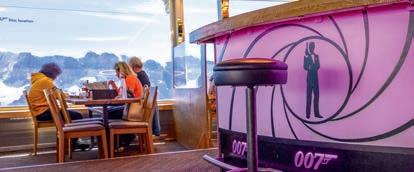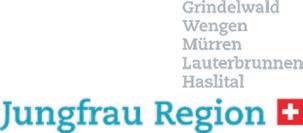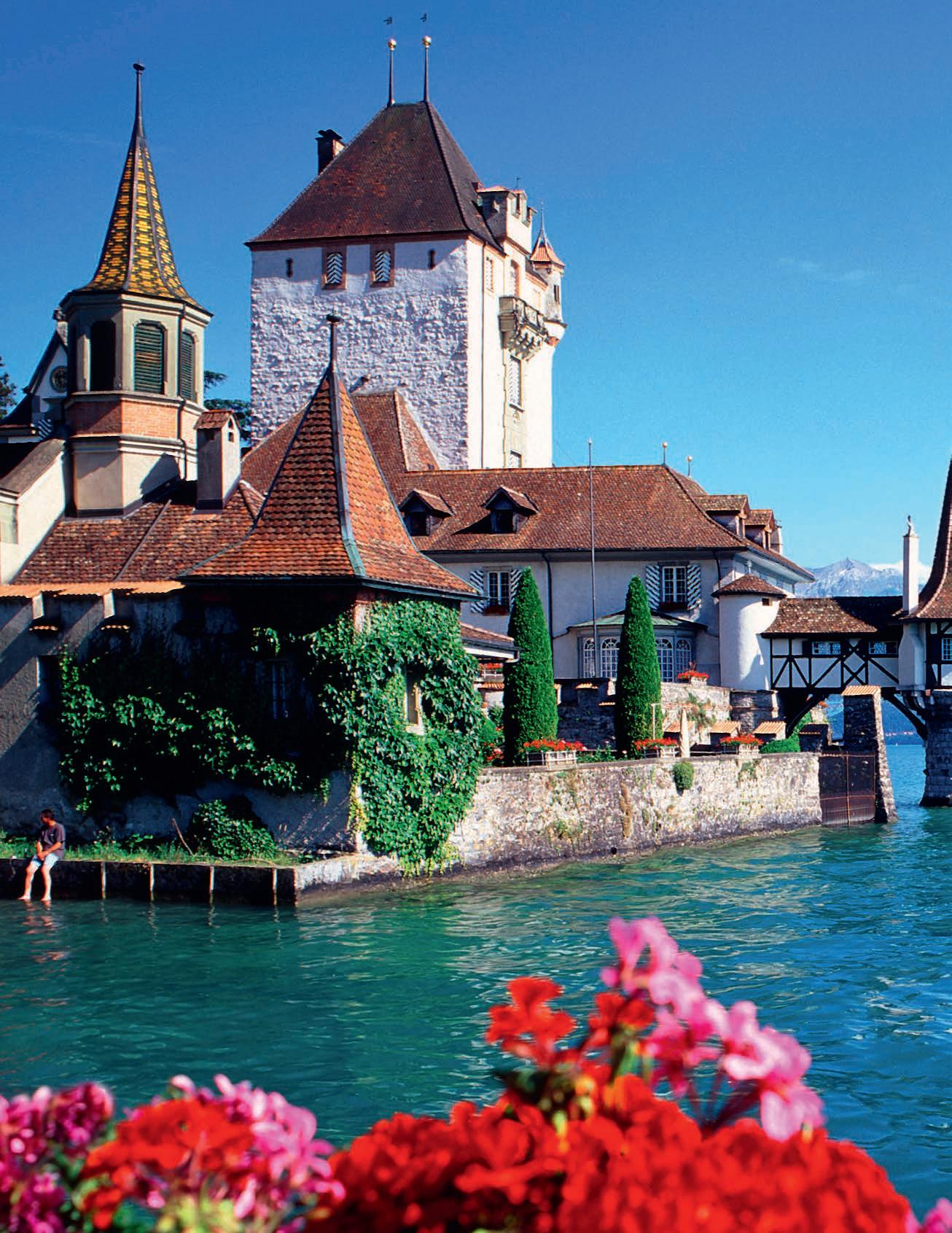
13 minute read
Claim your free gift, or choose to donate it to a good cause. See for details
COMMUNE WITH NATURE IN ADELBODEN
A centre for hiking and biking, as well as home to a famously challenging Ski World Cup giant slalom race in winter, the mountain village of Adelboden thrives on the nature it inhabits. The village comprises a clutch of traditional wooden chalets spreading from the bowl of the valley up the flowerstrewn slopes that surround it. Above are the high peaks of the Wildstrubel massif, still sprinkled with snow even in high summer, whose meltwater runs tumbling down over cliffs to form the mighty Engstligen Falls.
Advertisement
Take the bus or drive to the base of the falls to see them up close via an easy woodland hiking path. Or view them from the Engstligenbahn cable car, which rises alongside the falls to the high alpine pasture above, known as the Engstligenalp. More intrepid visitors can don a helmet and harness and ascend using the Chäligang via ferrata, a steep but simple climb along a fixed rope in view of the falls. Or follow in the hoof-steps of local cows on the mountain trail from Unter dem Birg to Engstligenalp, which the cattle tackle every year to spend summer on the Alps. Their descent in the autumn – known as the Alpabzug – is a real spectacle and, pre-COVID-19, was a popular day out.
The Engstligenalp is a satisfying place to spend time and the starting point for many hiking trails. Surrounded by a semi-circle of peaks, the Engstligenalp’s flat plateau makes for an easy walk (in winter, it’s ideal for cross-country skiing), while a more undulating hiking loop leads down to the cliff where the water drops sharply over the edge. Those looking for something more demanding can take the high alpine trail from here all the way over the Chindbettipass and eventually to Leukerbad. Or why not take the Gemmipass from Leukerbad to the Gemmi region for views over the Daubensee lake? Whatever exertion you choose, fortify yourself first with a hearty portion of Älplermagronen (Swiss macaroni cheese) in the mountain restaurant.
Keen mountain bikers should head to one of the other peaks surrounding Adelboden. Tschentenalp sits on the opposite side of the valley facing Engstligenalp and is accessed by another cable car or by bike along a trail that winds its way up from the village through the Tschent forest. At the top, channel your inner child on the giant swing, which stands on a ridge looking out over the valley and village below.
Taking in the view as you swing, to the right you’ll see the Chuenisbärgli mountain, where the Ski World Cup slalom and giant slalom races have been held every year since 1956. Also visible is the Sillerenbühl, from where you can reach the heart of Trottiland, the name given to the 45km of trails designed for trotti-bikes (stand-up scooters), which can be hired on site. Whizzing down the mountain roads past grazing cattle and alpine flowers is a freeing – not to mention extremely fun – way of experiencing the beautiful landscape.
From the top of the Sillerenbühl it’s possible to take another gondola on to Hahnenmoos, a tranquil spot overlooking a mountain lake that is the starting point for further biking and hiking trails, as well as one rather unusual experience: a walk with goats.
Sabina Bircher is an Adelboden local who looks after the animals, all belonging to rare Swiss breeds, allowing visitors to walk with them. On a stroll around the Hahnenmoospass or a longer hike of your choosing – at goat pace, naturally – you’ll come to know Matilda, Trax and the other goats as they nibble their choice of alpine flowers and scrap like squabbling siblings.
The Hahnenmoospass is also the highest point on the Adelboden-Lenk stage of the extensive Via Alpina, one of Switzerland’s long-distance hiking trails, which crosses 14 alpine passes on its 390km route across Switzerland. The 14km stage starts in Adelboden then heads up to the Hahnenmoospass before descending to Lenk, offering a snapshot of the mountain vistas, verdant pastures, forests and moorlands that make up the region. Do it in reverse and you can end your day in the refreshing water of the Gruebi, Adelboden’s renovated 1930s outdoor swimming pool and spa which is well placed to soothe your aching limbs while you bask in the view of the nature you’ve come to know.
Verdant valleys
(clockwise from top right) A traditional wooden chalet in Adelboden; ride a trotti-bike in Trottiland; a cow grazing on the Engstligenalp; hiking near the Engstligen Falls; a mountain hut in Adelboden
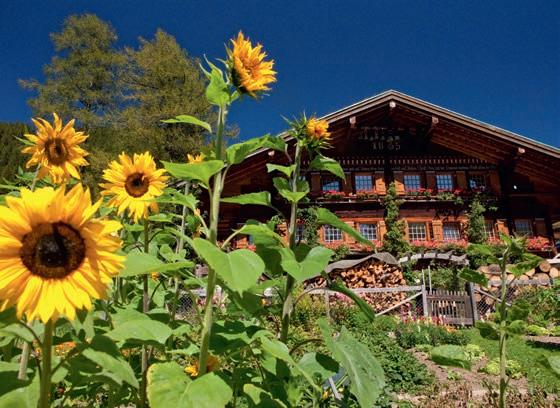

HAVE AN ADVENTURE IN INTERLAKEN
You need only witness paragliders landing in Interlaken’s central Höhematte park to understand why this town is regarded as the adventure capital of Europe. Bigger and busier than Adelboden, with a generous portion of luxury hotels, and positioned between two lakes (hence the name), its pretty Old Town retains an alpine feel. It’s likely to be on any visitor’s itinerary for good reason: not only is it just under an hour from the Swiss capital, Bern, but Interlaken’s transport links make it the ideal base for exploring the surrounding area.
Get your bearings at the Harder Kulm viewing point, known as the ‘top of Interlaken’. The funicular, not far from the town centre, will take you to the 1,322m platform from where you can see Lake Thun and Lake Brienz puddle below, with Interlaken sandwiched between them. In the distance are the mountains of the Jungfrau region, easily accessible from the town’s two train stations, while the ferry terminals on both lakes offer boat trips. Visit the town of Thun, with its 12th-century castle and flower-strewn bridges, as well as the woodcarving village of Brienz and various other hamlets dotted around each lakeshore.
A 15-minute glide from Brienz over the milky-turquoise water of its namesake lake (or an hour by boat from Interlaken) brings you to Giessbach, which has long enticed visitors due to the waterfall that cascades down the rocks in summer. It’s no wonder that it was thought of as such an ideal location for a hotel: the Grandhotel Giessbach was built in 1873, at the start of the Belle Epoque era, and its castle-like turrets, grand stairways and panoramic terrace guarantee it remains hugely popular today.
Originally, guests were required to walk up from the lakeshore to the hotel (or be carried in a sedan chair, if wealthy enough), but in 1879 a funicular railway was built to make quick work of the short but steep hill. These days, the hotel has retained its sense of history and occasion while also ensuring it preserves the nature that surrounds it, a task entrusted to ranger Thomas Herren and his team, who offer tours of the 220,000 square-metre grounds, now a conservation area. The garden includes an unchlorinated swimming pool that draws its water from the Giessbach waterfall. Nearby, several greenhouses nurture tomatoes, herbs and other plants grown for use in the hotel’s kitchens, as well as flowers to supply its florists, who keep the building beautifully decorated. Above the hotel, walking paths wind through an ancient forest to a viewing platform where a lighthouse was originally used as a “rooms vacant” signal to the people of Brienz, the other side of the lake.
The village of Brienz is well worth crossing the lake to visit. Renowned in Switzerland as a centre of woodcarving – its woodcarving school, founded in 1884, is the only one in the country – it is home to a number of artisan workshops where local craftspeople carve figurines and household implements using wood from nearby forests. The town’s Swiss Woodcarving Museum delves into the history of the craft in the region, with carvers working onsite.
If weather permits, jump on the cogwheel steam train up to the Brienzer Rothorn on a railway line built way back in 1892. Chugging and sighing up to 2,350m, the steampowered locomotive and its little red carriages don’t appear to have changed much since then, and are all the more charming for it. On certain days, the train stops halfway at Planalp for a snack break of sausages cooked in the locomotive’s original steam kettle.
Another train taking passengers back in time is the cogwheel railway from Wilderswil – just outside Interlaken – to Schynige Platte. Built just a year after the Brienzer Rothorn train, this remarkable piece of Swiss engineering winds slowly up through woodland for more than an hour until depositing passengers in a peaceful mountain haven at 1,967m, high above the two lakes. Here, linger over lunch in the restaurant, stroll around the alpine garden, where gentians, alpine roses and rare Edelweiss are tended to by gardener Paul Brunner (who offers tours), or head off into a wilderness occupied by ibex and marmots on one of the area’s many hiking trails. Arguably the most gratifying is the six-hour trail to First via the Faulhorn, where one of the country’s oldest alpine hotels rewards your efforts with fine views, a hearty meal and a cosy bed: a combination of adventure and comfort that sums up this area in a nutshell.
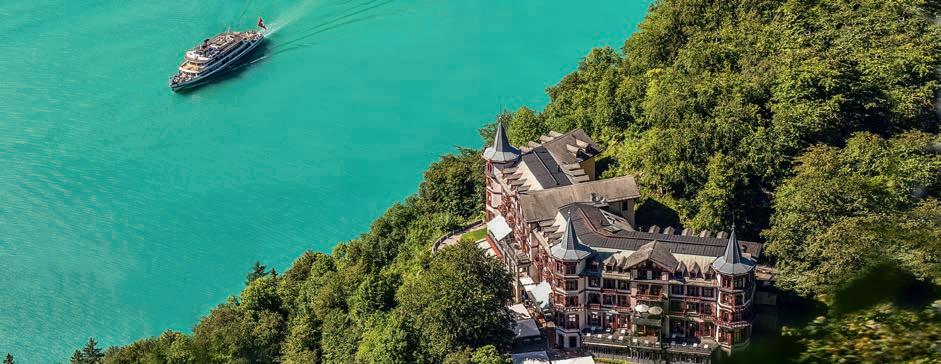
Peak panoramas
(left-right) The red train rises to 1,967m and crosses the Schynige Platte, offering views over two lakes; the historic Grandhotel Giessbach overlooks Brienz lake and is surrounded by nature
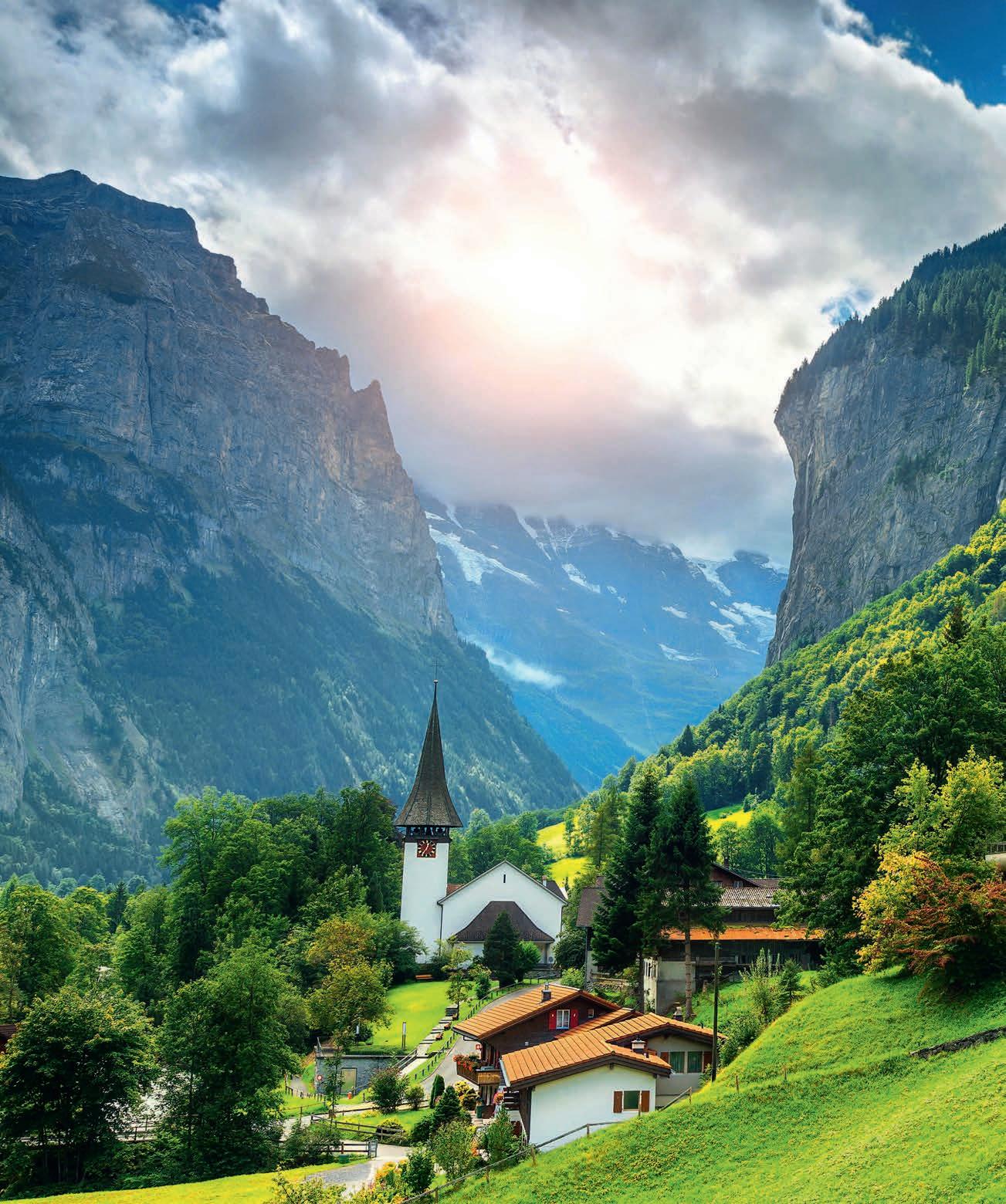
Chasing waterfalls
(left-right) The Staubbach Falls is one of 72 waterfalls in the Lauterbrunnen Valley; spot ibex in the Jungfrau Region
TEST YOUR HEAD FOR HEIGHTS IN THE JUNGFRAU REGION
The mountainous heart of the Bernese Oberland is the Jungfrau Region, dominated by a mighty trio of peaks: the Eiger, Mönch and Jungfrau (it’s easy to remember the order – the ‘monk’ keeps apart the ‘ogre’ and the ‘young woman’). The area captured JRR Tolkien’s heart on a trip to Switzerland in 1911, so much so that both The Hobbit and The Lord of the Rings are inspired by the landscape he explored. Visiting Lauterbrunnen, it’s easy to see why: this village sits at the mouth of a lush valley, cliffs rising each side, the wispy Staubbach waterfall tumbling from on high.
Don’t be fooled, though; the power of water is nowhere more evident than here. Around a 30-minute walk brings you to the Trümmelbach Falls that are anything but lightweight. A lift takes visitors halfway up the cliff from where you can walk the rest of the way up and back down again, following the hypnotic passage of the water as it pummels a path through the rock like a wild waterpark ride.
On the other side of the valley, two cable cars allow access to the car-free mountain village of Mürren. The more direct of the two departs from Stechelberg, near the Mürrenbach Falls. However, if there’s time, take the more leisurely route from Lauterbrunnen village to Grütschalp from where it’s a flat and easy 90-minute hike to Mürren. Along the way, linger on a bench and take in the view of the big three looming large over the other side of the valley. Be sure to stop at a farm to buy Alpkäse, cows milk cheese made right there on the pasture, as the cows graze nearby.
Mürren was put on the map by the Inferno ski race (the largest amateur ski race in the world, which began in 1928) and, later, by a certain James Bond, who came to the village in the form of George Lazenby to film On Her Majesty’s Secret Service in the late 1960s. The village has nevertheless retained its authentic alpine charm, and there are no glitzy high-rise hotels here; instead you’ll find smaller, family-run hotels and friendly locals who are proud to show off their beautiful village to visitors.
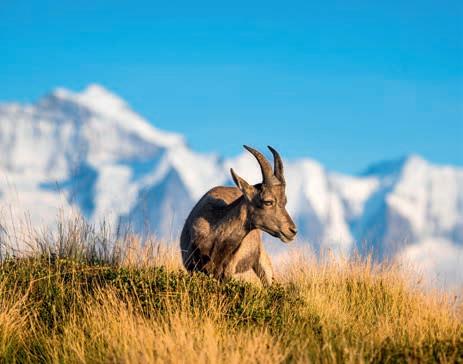
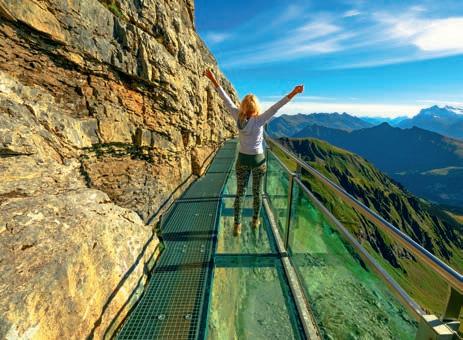
One must-do is a trip on the Schilthorn cable car, which rises up to 2,970m, high above the village. Alight at Birg, the mid station, to test your head for heights on the Thrill Walk, a series of see-through steel and glass walkways clinging to the cliff, before carrying on up to the summit of the Schilthorn and Schilthorn-Piz Gloria, the revolving restaurant that occupies it. Partly financed by the Bond franchise’s producers, who selected it as Blofeld’s lair before construction was even completed, Schilthorn-Piz Gloria also features an exhibition about Lazenby’s only outing as 007, including anecdotes about locals who were employed as stunt doubles and skiing extras in the film. Step outside onto the viewing platform for a 360-degree view: on a clear day it’s possible to see hundreds of summits and as far away as Mont Blanc in France.
The landscape below the Schilthorn-Piz Gloria is rich with hiking opportunities. From Mürren village, the moderate Northface Trail takes a circular route up through pastures and forests to reach Allmendhubel, Mürren’s local mountain. Here, kick back with a drink at the restaurant or admire the alpine blooms along the Flower Trail before hitching a ride on the small funicular back down to the village.
More energetic hikers might prefer the Grauseeli Loop, a full-day hike up to the Schilthornhütte mountain cabin. The descent passes the mirror-like Grauseeli, a small lake in a bowl below the Schilthorn-Piz Gloria. Cool off in the water before continuing on through flower-strewn grass. Look out for eagles, buzzards and paragliders in the skies overhead as marmots bound through the grass below, calling to each other in their bird-like chirp. From here, either take the steep downhill path that joins the Northface trail back towards Mürren, or traverse the Wasenegg ridge to Bryndli, a lone peak whose peaceful summit, facing the Eiger, Mönch and Jungfrau, is a glorious place to take a break before tackling the descent to come.
Down is certainly as impressive as up in these mountains, as demonstrated by Mürren’s via ferrata, a fixed climbing route that, unlike most of its kind, descends rather than ascends, taking those who dare on a downwards traverse of the sheer cliffs below the village towards the hamlet of Gimmelwald. Here, in a place that’s home to more cows than people, you can relax and recuperate with a local Schwarz Mönch beer, a perfect place to reflect on your adventurous time in Bernese Oberland.
Dizzying heights
(clockwise from top left) The Thrill Walk at Birg; hiking past the Grauseeli lake in Mürren; the revolving restaurant Piz Gloria at the top of the Schilthorn pays homage to the mountain’s Bond movie history
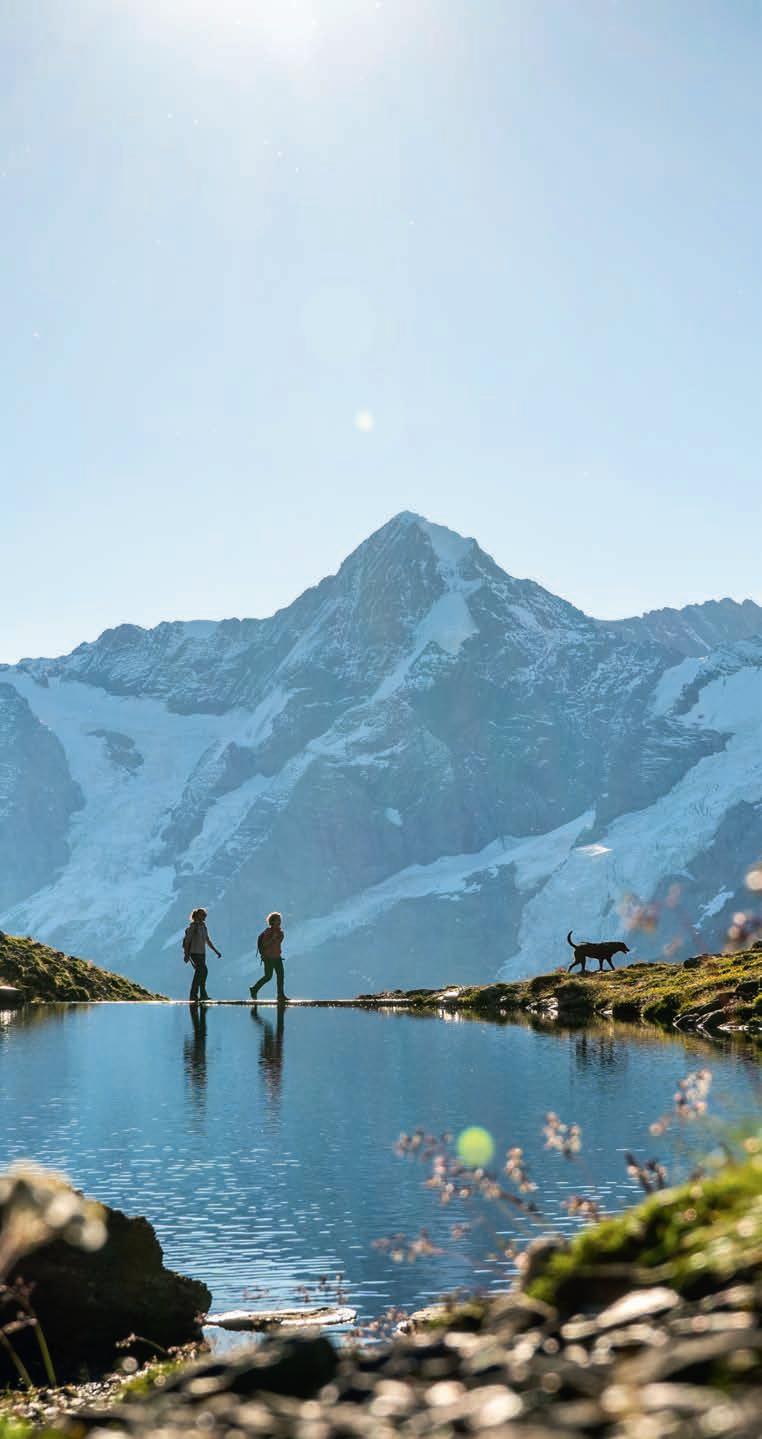
ESSENTIAL INFORMATION How to get there and around:
SWISS offers more than 160 weekly flights from London City, Heathrow, Manchester, Birmingham, Edinburgh and London Gatwick (seasonal) to Zurich or Geneva. From Zurich airport it’s around 1.5 hours by train to Bern, and from Geneva it’s around 2 hours. From Bern, you’ll ride along the shore of Lake Thun to Interlaken. Change at Spiez for Adelboden, or at Interlaken for connections to the Jungfrau Region. The Swiss Travel Center offers various railcards, and The Swiss Travel Pass is available from £186 for 3 days in second class.
Where to stay:
• The Cambrian Adelboden: This contemporary alpine hotel has 71 spacious rooms, an outdoor infinity pool and spa, a breakfast terrace with mountain views, and menus designed by Welsh chef Bryn Williams. thecambrianadelboden.com • Hotel Carlton-Europe Vintage: Near Interlaken Ost train station, this upmarket place combines contemporary comforts with vintage style, and features a restaurant, a burger joint and a wine cellar. carltoneurope.ch • Hotel Eiger: This hotel in Mürren offers homely, elegant rooms, some with views of the Eiger, Mönch and Jungfrau, directly across the valley. hoteleiger.com
Where to eat:
• Alte Taverne, Adelboden, offers grilled meats to share, carved at the table, as well as fondue and salads, in a typically Swiss wooden chalet-like building. alte-taverne.ch • Restaurant Taverne in the Hotel Interlaken serves a menu of imaginative modern Swiss cuisine, including a four-course tasting menu. restauranttaverne.ch • Restaurant Piz Gloria is the 360-degree revolving restaurant on top of the Schilthorn. Choose from a menu of typical regional dishes, Bond-branded burgers or the all-you-can eat brunch. schilthorn.ch
